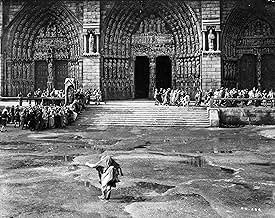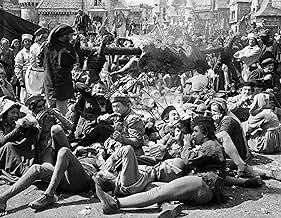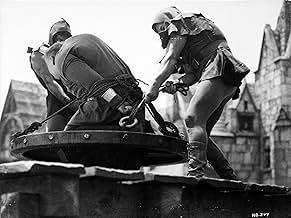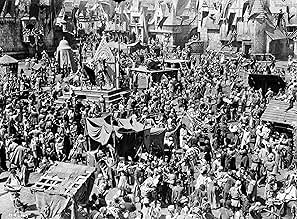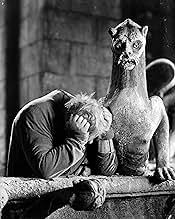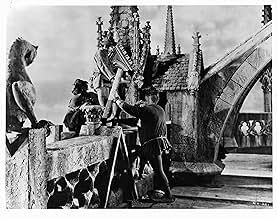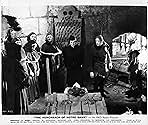IMDb रेटिंग
7.8/10
13 हज़ार
आपकी रेटिंग
अपनी भाषा में प्लॉट जोड़ेंIn 15th-century France, a gypsy girl is framed for murder by the infatuated Chief Justice, and only the deformed bellringer of Notre Dame Cathedral can save her.In 15th-century France, a gypsy girl is framed for murder by the infatuated Chief Justice, and only the deformed bellringer of Notre Dame Cathedral can save her.In 15th-century France, a gypsy girl is framed for murder by the infatuated Chief Justice, and only the deformed bellringer of Notre Dame Cathedral can save her.
- निर्देशक
- लेखक
- स्टार
- 2 ऑस्कर के लिए नामांकित
- 1 जीत और कुल 2 नामांकन
Cedric Hardwicke
- Frollo
- (as Sir Cedric Hardwicke)
Helene Reynolds
- Fleur de Lys
- (as Helene Whitney)
Minna Gombell
- Queen of Beggars
- (as Mina Gombell)
Rod La Rocque
- Phillippe
- (as Rod LaRocque)
फ़ीचर्ड समीक्षाएं
A sweeping claim? Perhaps. But despite the presence in Hollywood over sixty subsequent years of Ford, Wyler, Kubrick, Coppola, Scorsese et al, The Hunchback of Notre Dame remains as fresh, as emotionally resonant and yes as powerfully artistic as the day it was made. What constitutes 'art' is of course a personal matter, just as the Breughel-like compositions of Hunchback might be as mystifying to someone whose favourite film is A Clockwork Orange (Lichtenstein?). But what makes Hunchback so satisfying as art is precisely that its makers didn't set out with art in mind. Dieterle and his co-creators embarked on the project with the aim of telling a great yarn, making it look authentic, and above all ENTERTAINING the audience. It is to this end that the Grand Guignol excesses of the novel were trimmed or altered, and the Hollywood bittersweet ending imposed. Audiences filed out with their Kleenex in hand having witnessed a three-ring circus of a movie, then went home to read the war-soaked newspapers.
Virtually every frame of this movie could be taken in isolation, made into a poster and hung on a wall. Examples include Gringoire cradling the dying Clopin as a rivulet of lead trickles past in the background, the voyeuristic eye of Quasimodo peering through fence palings at the dancing Esmeralda - I could go on and on. And pervading it all is the magnificent score of Alfred Newman, surely his finest ever.
Rather than sing its obvious praises, the film can simply speak for itself. As narrative, as character, as cinema craft, it is totally successful throughout. The Hunchback of Notre Dame is my favourite film of all time, bar none. Ten out of ten
Virtually every frame of this movie could be taken in isolation, made into a poster and hung on a wall. Examples include Gringoire cradling the dying Clopin as a rivulet of lead trickles past in the background, the voyeuristic eye of Quasimodo peering through fence palings at the dancing Esmeralda - I could go on and on. And pervading it all is the magnificent score of Alfred Newman, surely his finest ever.
Rather than sing its obvious praises, the film can simply speak for itself. As narrative, as character, as cinema craft, it is totally successful throughout. The Hunchback of Notre Dame is my favourite film of all time, bar none. Ten out of ten
Considering that RKO was not renowned for epic film making, the production mounted for this version of Victor Hugo's classic story is surprisingly elaborate and effective.
The Paris set is a beautiful creation and possibly the greatest work by Van Nest Polglase, who with the producer Pan Berman is chiefly remembered today for the elegant art-deco designs for the Astaire-Rogers musicals.
The centrepiece of this remarkable set is the replica of Notre Dame cathedral which was only built to 50% height of the original; the towers above were added as an optical effect by use of a hanging miniature in some shots and by incorporating a glass painting in long shots. It's very convincing.
Dieterle was the perfect choice to direct this story. A student (and later collaborator) of Max Reinhardt, he marshals the huge crowd scenes (no CGi here - those thousands of peasants are all real people) with aplomb and his mastery of expressionistic imagery informs every frame.
Alfred Newman brought an intelligence to the musical score rare in Hollywood. His on screen credit "Musical adaptation and original composition by" reflects his skillful combining of original renaissance choral music by Tomas Luis de Victoria with his own work. He also uses a stirring Hallelujah chorus by uncredited Austrian Jewish émigré Ernst Toch (in Hollywood to escape the Nazis) for the memorable scene where Quasimodo rescues Esmeralda, reprised at the film's closing sequence as the camera pulls back from Notre Dame.
It's a great pity that a better restoration cannot be achieved for this beautiful film than is currently available on DVD. While the source print is serviceable, it is often poorly defined and suffers from many scratches. Perhaps it is the only print now extant? I would also love to see the original trailer rather than the re-release version.
While some may wish Basil Rathbone could have been released from contract at Universal to play Frollo, I think Cedric Hardwicke was ideal casting. As for Laughton, this may well be his signature role and a masterly example of great acting with hardly any dialogue at all.
As Mr Sinatra once said - "You can wait around and hope - but you won't see the likes of this again"
The Paris set is a beautiful creation and possibly the greatest work by Van Nest Polglase, who with the producer Pan Berman is chiefly remembered today for the elegant art-deco designs for the Astaire-Rogers musicals.
The centrepiece of this remarkable set is the replica of Notre Dame cathedral which was only built to 50% height of the original; the towers above were added as an optical effect by use of a hanging miniature in some shots and by incorporating a glass painting in long shots. It's very convincing.
Dieterle was the perfect choice to direct this story. A student (and later collaborator) of Max Reinhardt, he marshals the huge crowd scenes (no CGi here - those thousands of peasants are all real people) with aplomb and his mastery of expressionistic imagery informs every frame.
Alfred Newman brought an intelligence to the musical score rare in Hollywood. His on screen credit "Musical adaptation and original composition by" reflects his skillful combining of original renaissance choral music by Tomas Luis de Victoria with his own work. He also uses a stirring Hallelujah chorus by uncredited Austrian Jewish émigré Ernst Toch (in Hollywood to escape the Nazis) for the memorable scene where Quasimodo rescues Esmeralda, reprised at the film's closing sequence as the camera pulls back from Notre Dame.
It's a great pity that a better restoration cannot be achieved for this beautiful film than is currently available on DVD. While the source print is serviceable, it is often poorly defined and suffers from many scratches. Perhaps it is the only print now extant? I would also love to see the original trailer rather than the re-release version.
While some may wish Basil Rathbone could have been released from contract at Universal to play Frollo, I think Cedric Hardwicke was ideal casting. As for Laughton, this may well be his signature role and a masterly example of great acting with hardly any dialogue at all.
As Mr Sinatra once said - "You can wait around and hope - but you won't see the likes of this again"
Losy in the monatge of 1939 films ...somewhat is a film I believe is more enriching and florid than " Gone With The Wind" and possibly just as romantic as " Wuthering Heights"
Laughton's performance is one of the most astonishing put on film ever. A Stellar cast is in place from O' Hara to O' Brien..What can I say , Thomas Mitchell who probably graced more films than any other actor is superb.
Hugo,s timeless classic is brought to life in black and white and with sets that make you feel ..you are there.
The great Cedric Hardwicke potrays the tormented one and for sure ..its 116 minutes of pure film making ..and it all takes place on fools day....
CP
Laughton's performance is one of the most astonishing put on film ever. A Stellar cast is in place from O' Hara to O' Brien..What can I say , Thomas Mitchell who probably graced more films than any other actor is superb.
Hugo,s timeless classic is brought to life in black and white and with sets that make you feel ..you are there.
The great Cedric Hardwicke potrays the tormented one and for sure ..its 116 minutes of pure film making ..and it all takes place on fools day....
CP
10llltdesq
The best of the many versions of The Hunchback of Notre Dame, for my money, is this one, although Lon Chaney's is a close second. Despite a Hollywood tendancy to change the novel's ending so as not to depress the cash customers (although, pray tell, if you're going to change the ending, why does no one ever see Quasimodo sailing off to Tahiti with the girl? Rule # 1: strong, handsome poets beat out disfigured cripples every time, even if they're heroes. This is more true in real life than in the movies. Take my word for this, I know from painful experience *sigh*)
Charles Laughton is exceptional and Maureen O'Hara would make any man swoon and is perfect for the part of Esmerelda. The support includes the usual suspects-Thomas Mitchell, Harry Davenport and many other familiar character actors. Strike up the band and start the parade. Thunderous applause. Most highly recommended.
Charles Laughton is exceptional and Maureen O'Hara would make any man swoon and is perfect for the part of Esmerelda. The support includes the usual suspects-Thomas Mitchell, Harry Davenport and many other familiar character actors. Strike up the band and start the parade. Thunderous applause. Most highly recommended.
Charles Laughton's boisterous portrayal of Quasimodo and Maureen O'Hara's charm as Esmerelda are two of the things that make this version of "The Hunchback of Notre Dame" a fine production that still works very well. Most of the versions of the story have been at least watchable, because the Victor Hugo novel provides so much good material to work with, much of it well-suited for cinema. This adaptation, though, is one of the best at making good use of what it offers.
It's interesting to compare this picture with the 1923 Lon Chaney version - not for the sake of ranking them, since both are fully worthy of attention in their own right, but because they offer somewhat different strengths, and because they emphasize somewhat different aspects of the story.
Chaney and Laughton are both quite effective as Quasimodo, each giving an interpretation of the character that corresponds to the actor's skills. Laughton brings out Quasimodo's feelings and perspective quite well. In this version, for example, the flogging scene is longer and more detailed, and it is one of Laughton's most effective scenes. Chaney is particularly good at reacting to the other characters and their actions. Both give the character a distinctive and memorable look.
O'Hara is also one of this adaptation's strengths. Patsy Ruth Miller was good in the Chaney version, but O'Hara has the advantage of spoken dialogue, and she makes the character of Esmerelda her own.
While the Chaney version especially emphasized the atmosphere, this one has quite a bit of action. The tumultuous climactic sequences are done quite well, and they leave a vivid impression. Overall, this is a very satisfying adaptation of the fine classic novel.
It's interesting to compare this picture with the 1923 Lon Chaney version - not for the sake of ranking them, since both are fully worthy of attention in their own right, but because they offer somewhat different strengths, and because they emphasize somewhat different aspects of the story.
Chaney and Laughton are both quite effective as Quasimodo, each giving an interpretation of the character that corresponds to the actor's skills. Laughton brings out Quasimodo's feelings and perspective quite well. In this version, for example, the flogging scene is longer and more detailed, and it is one of Laughton's most effective scenes. Chaney is particularly good at reacting to the other characters and their actions. Both give the character a distinctive and memorable look.
O'Hara is also one of this adaptation's strengths. Patsy Ruth Miller was good in the Chaney version, but O'Hara has the advantage of spoken dialogue, and she makes the character of Esmerelda her own.
While the Chaney version especially emphasized the atmosphere, this one has quite a bit of action. The tumultuous climactic sequences are done quite well, and they leave a vivid impression. Overall, this is a very satisfying adaptation of the fine classic novel.
क्या आपको पता है
- ट्रिवियाThe scene in which Quasimodo rings the cathedral bells for Esmeralda was shot the day World War II began in Europe. The director and star were so overwhelmed, the scene took on a new meaning, with Charles Laughton ringing the bells frantically and William Dieterle forgetting to yell "cut." Finally, the actor just stopped ringing when he became too tired to continue. Later, Laughton said, "I couldn't think of Esmeralda in that scene at all. I could only think of the poor people out there, going in to fight that bloody, bloody war! To arouse the world, to stop that terrible butchery! Awake! Awake! That's what I felt when I was ringing the bells!"
- गूफ़The cathedral is shown as having a full flight of steps up to the front doors. Notre Dame has always been more or less level with the square (le Parvis).
- भाव
[Last lines]
Quasimodo, the bell-ringer: [to one of the stone gargoyles] Why was I not made of stone - like thee?
- क्रेज़ी क्रेडिटPROLOGUE: "With the end of the 15th Century, the Middle Ages came to a close. Europe began to see great changes. France, ravaged by a hundred years of war, at last found peace. The people under Louis XI felt free to hope again --- to dream of progress. But superstition and prejudice often stood in the way, seeking to crush the adventurous spirit of man."
- इसके अलावा अन्य वर्जनAlso available in a computer colorized version.
- साउंडट्रैकAve Maria
(1572) (uncredited)
Music by Tomás Luis de Victoria
Sung by mixed chorus during opening credits
टॉप पसंद
रेटिंग देने के लिए साइन-इन करें और वैयक्तिकृत सुझावों के लिए वॉचलिस्ट करें
विवरण
- रिलीज़ की तारीख़
- कंट्री ऑफ़ ओरिजिन
- आधिकारिक साइट
- भाषा
- इस रूप में भी जाना जाता है
- Hunchback of Notre Dame
- फ़िल्माने की जगहें
- उत्पादन कंपनी
- IMDbPro पर और कंपनी क्रेडिट देखें
बॉक्स ऑफ़िस
- बजट
- $18,00,000(अनुमानित)
- चलने की अवधि
- 1 घं 56 मि(116 min)
- रंग
- पक्ष अनुपात
- 1.37 : 1
इस पेज में योगदान दें
किसी बदलाव का सुझाव दें या अनुपलब्ध कॉन्टेंट जोड़ें


